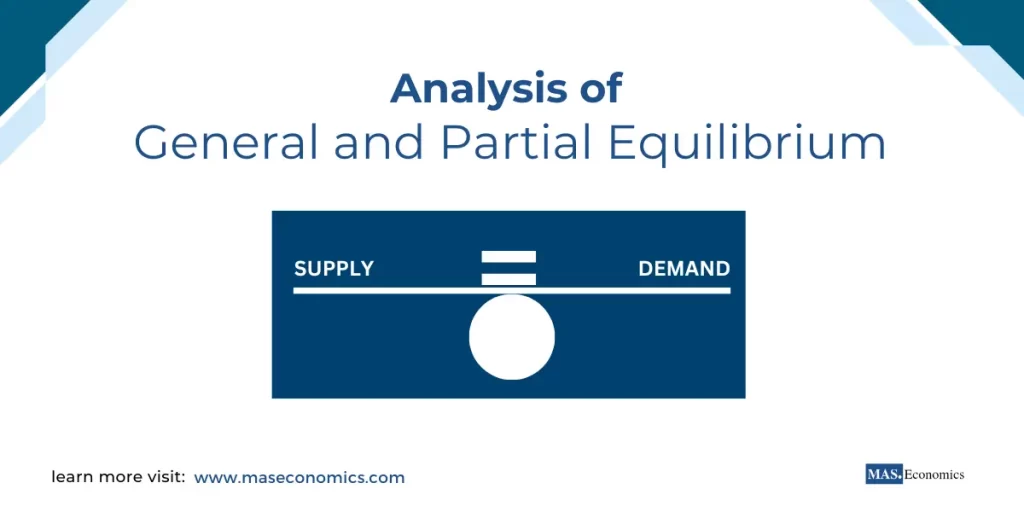In economics, equilibrium is the cornerstone for understanding how markets operate and reach stability. When an economy reaches equilibrium, supply and demand balance each other across markets, and no further changes are required unless external factors disrupt the balance. Economists have developed two critical methods for analyzing equilibrium—general equilibrium and partial equilibrium. While partial equilibrium focuses on isolated markets, general equilibrium considers the entire economic system.
In this post, we’ll explore these two types of analysis, introduce Walras’ Law, and explore the broader academic aspects of equilibrium, including mathematical modeling, real-world applications, and theoretical limitations.
What is Equilibrium in Economics?
In economic terms, equilibrium occurs when the quantity of goods demanded by consumers equals the quantity supplied by producers. At this point, there is no incentive for price changes, and the market “clears.” This equilibrium condition can be analyzed in isolation (partial equilibrium) or a broader economic context (general equilibrium).
General Equilibrium
General equilibrium theory, developed by Léon Walras, seeks to explain how supply and demand simultaneously balance across all markets in an economy. Rather than examining individual markets in isolation, general equilibrium takes a holistic approach by considering the interactions between multiple markets. This allows economists to understand how shocks in one market (like a rise in oil prices) can ripple through the economy, affecting other markets (such as the transportation and manufacturing sectors).
In general equilibrium, we assume that all economic agents (consumers and firms) act to maximize their utility or profit. Prices adjust so that all markets simultaneously reach equilibrium, where supply equals demand across the board.

Understanding General Equilibrium Through Mathematical Modeling
General equilibrium is often modeled using a system of equations that capture the behavior of consumers and firms across multiple markets. In its simplest form, for a market with two goods (good X and good Y), general equilibrium can be represented as:
In more advanced models, like the Arrow-Debreu general equilibrium model, the economy is described by:
- Demand equations for each good, represent how much consumers want to buy, based on prices and income.
- Supply equations for each good, showing how much firms are willing to produce, based on production costs and technology.
- Price equations adjust to clear each market, meaning that for every good, supply equals demand.
In these models, equilibrium is reached when prices and quantities in all markets simultaneously balance, ensuring that no excess supply or demand exists. The market-clearing condition can be expressed mathematically as:
Where \(x_i(p)\) represents consumer demand, \(y_j(p)\) represents firm supply, and \(p\) denotes the price of goods. \(N\) and \(M\) are the number of consumers and firms, respectively. This set of equations adjusts to find prices that clear all markets simultaneously, reflecting the interdependence of the economy.
Arrow-Debreu Model of General Equilibrium
The Arrow-Debreu model is the most famous formalization of general equilibrium. It assumes that all markets operate perfectly, with rational consumers, firms, and complete markets. This model mathematically demonstrates the existence of equilibrium in a competitive economy, where no individual can improve their utility without making someone else worse off.
Existence and Uniqueness of General Equilibrium
A key aspect of general equilibrium theory is the existence and uniqueness of equilibrium. We can prove that a general equilibrium exists under certain conditions, such as convex preferences and complete markets. The Arrow-Debreu theorem formalizes this, showing that an equilibrium can always be found if certain assumptions hold.
However, uniqueness is not guaranteed. Multiple equilibria may exist, or the economy may settle into a different equilibrium based on initial conditions or external shocks.
Stability of General Equilibrium
General equilibrium theory also deals with how an economy adjusts to changes, i.e., the stability of equilibrium. If an economy is knocked out of equilibrium—perhaps by a technological shock or changes in consumer preferences—will it naturally return to a new equilibrium?
One mechanism used to explain this is Walras’ tâtonnement process. This process suggests that prices adjust continuously until supply equals demand across all markets. For example, if a product has excess demand, its price will rise until equilibrium is restored, and vice versa for excess supply. In reality, markets may not constantly adjust smoothly due to frictions like transaction costs or market imperfections.
Partial Equilibrium
While general equilibrium considers the entire economy, partial equilibrium narrows the focus to a single market. Alfred Marshall developed this method, which assumes that changes in one market do not affect others. Partial equilibrium analysis helps understand how changes in supply or demand in one market (like the wheat market) affect the price and quantity of that specific good.
For example, suppose wheat prices rise due to a bad harvest. In that case, partial equilibrium analysis helps us understand how this price change affects wheat demand, assuming that other factors—such as wages, fuel prices, or the demand for other crops—remain constant.

Walras’ Law and Market Interdependence
A critical insight from general equilibrium theory is Walras’ Law, which states that if all but one market in an economy is in equilibrium, the last market must also be in equilibrium. This underscores the interconnectedness of markets. According to Walras’ Law, a shortage or surplus in one market must be balanced by a corresponding shortage or surplus elsewhere in the economy.
Example
Imagine a scenario where there is an excess supply of labor in the job market (i.e., unemployment). According to Walras’ Law, this excess supply must be offset by excess demand in another market, perhaps for goods and services. This suggests that imbalances in one area of the economy will be reflected elsewhere.
Comparative Statics and General Equilibrium
In addition to understanding the equilibrium, economists also study comparative statics, which analyzes how changes in external conditions affect equilibrium. For instance, how does a tax on carbon emissions affect the overall equilibrium in the energy and consumer goods markets? General equilibrium analysis helps answer these questions by considering all markets simultaneously.
Criticisms and Limitations of General Equilibrium Theory
While general equilibrium theory provides a comprehensive framework for understanding market interdependence, it is not without its criticisms:
Perfect Competition
General equilibrium models often assume perfect competition, meaning firms are price takers with no market power. However, in the real world, many industries exhibit monopolistic or oligopolistic behavior, where firms have significant control over prices.
Complete Markets
Assuming all markets exist and are complete (i.e., every good or service has a market) is highly unrealistic. Many real-world markets, like the healthcare or education markets, have incomplete information or are heavily regulated, leading to inefficiencies.
Rationality and Information
General equilibrium assumes that all agents have perfect information and act rationally to maximize utility. In practice, information asymmetry and irrational behavior often lead to market failures.
Real-World Frictions
Transaction costs, taxes, and regulations can distort markets, making it difficult for economies to achieve general equilibrium.
General vs. Partial Equilibrium: A Comparison
| Aspect | General Equilibrium | Partial Equilibrium |
|---|---|---|
| Scope | Entire economy and multiple markets | Single market studied in isolation |
| Interdependence | Considers how changes in one market affect others | Ignores other markets, assumes they remain constant |
| Methodology | Complex, requires advanced mathematical models | Simpler, used in microeconomic analysis |
| Key Figures | Léon Walras, Arrow-Debreu | Alfred Marshall |
| Applications | Analyzing entire economies, trade, policy-making | Focused on specific markets like taxation |

|
||
Conclusion
Both general and partial equilibrium analyses provide valuable insights into how markets function and reach stability. While general equilibrium offers a holistic view of the entire economy, partial equilibrium allows economists to study individual markets in isolation. Each has its strengths and limitations; understanding both is essential for analyzing complex economic systems.
Economists continue to build on these foundational theories, refining them to better account for real-world complexities, such as information asymmetry, market frictions, and monopolistic competition. By understanding how markets reach equilibrium, we gain a deeper understanding of economic dynamics, helping policymakers design better interventions for societal welfare.
FAQs:
What is equilibrium in economics?
In economics, equilibrium occurs when the quantity of goods demanded by consumers equals the quantity supplied by producers. At this point, market prices stabilize, and no further changes in supply or demand occur unless external factors disrupt the balance.
What is general equilibrium analysis?
General equilibrium analysis looks at the entire economy, considering the interactions and interdependencies between multiple markets. It examines how equilibrium is achieved when supply and demand balance across all markets simultaneously, considering the ripple effects that changes in one market can have on others.
What is partial equilibrium analysis?
Partial equilibrium analysis focuses on a single market in isolation, assuming that other markets remain constant. This approach simplifies the analysis by concentrating on the effects of supply and demand within one market, without considering interactions with other markets.
How does general equilibrium differ from partial equilibrium?
General equilibrium considers the entire economy, including the interrelationships between multiple markets, while partial equilibrium isolates one market, assuming that other markets remain unaffected. General equilibrium uses more complex mathematical models, whereas partial equilibrium is simpler and commonly used in microeconomic studies.
What is Walras’ Law?
Walras’ Law states that if all but one market in an economy is in equilibrium, the final market must also be in equilibrium. It highlights the interconnectedness of markets and suggests that surpluses or shortages in one market must be offset by imbalances in other markets.
What is the Arrow-Debreu model of general equilibrium?
The Arrow-Debreu model formalizes the concept of general equilibrium in a competitive economy. It assumes rational consumers, firms, and complete markets, and mathematically demonstrates that under certain conditions, an equilibrium exists where no agent can improve their utility without making someone else worse off.
What are the advantages of using general equilibrium analysis?
General equilibrium analysis provides a holistic view of the economy by showing how changes in one market affect others. This is particularly useful for analyzing broad economic policies, trade, and systemic shocks that impact multiple sectors simultaneously.
What are the limitations of general equilibrium theory?
General equilibrium theory often assumes perfect competition, complete markets, and rational behavior, which are not always realistic. It also overlooks real-world frictions like transaction costs, taxes, and regulations, which can prevent markets from achieving equilibrium in practice.
When is partial equilibrium analysis more appropriate?
Partial equilibrium analysis is more appropriate when analyzing the effects of changes in one specific market without needing to consider how other markets are affected. It is particularly useful for studying microeconomic issues, such as taxation or price changes in individual markets.
What is the role of comparative statics in general equilibrium analysis?
Comparative statics examines how changes in external factors, such as taxes or technological innovations, affect the equilibrium in various markets. It allows economists to predict how a new policy or external event will shift the overall economic equilibrium.
Thanks for reading! Share this with friends and spread the knowledge if you found it helpful.
Happy learning with MASEconomics



